Guide to eSignature: what it is, types of e- signature, legal validity and benefits.

There is no doubt that electronic signatures are here to stay.
The truth is that more and more professionals, companies and even individual professionals have already changed the way they sign documents, moving from paper to the digital environment. And those who have not yet done so, will not take long to do so.
As experts in digital trust solutions, in this guide we address the main topics you should know about electronic signatures, the different types of signatures that exist, their legal validity and the benefits of implementing them in business.
Contents
-
What is an electronic signature?
-
Electronic signature vs. digital signature
-
Benefits of electronic signatures in companies & enterprise
-
Legal validity of electronic signatures
-
Types of electronic signature
-
Which documents can I sign with electronic signature
-
Switch to eEvidence electronic signatures
What is an electronic signature?
E-signature is more of a legal concept used to describe the acceptance in electronic form of a document, agreement or contract, also in electronic form by one or more signatories.
Technically speaking, Regulation (EU) No. 910/2014 – the main regulatory framework on electronic signatures across the European Union – defines electronic signature as follows:
‘Electronic signature’ means data in electronic form which is attached to or logically associated with other data in electronic form and which is used by the signatory to sign;
Regulation (EU) No. 910/2014 (eIDAS Regulation)
Thus, this electronic data accompanies information, also in electronic format, such as a PDF contract or a company’s cookie policy on its website (yes, this is also an electronic signature!).
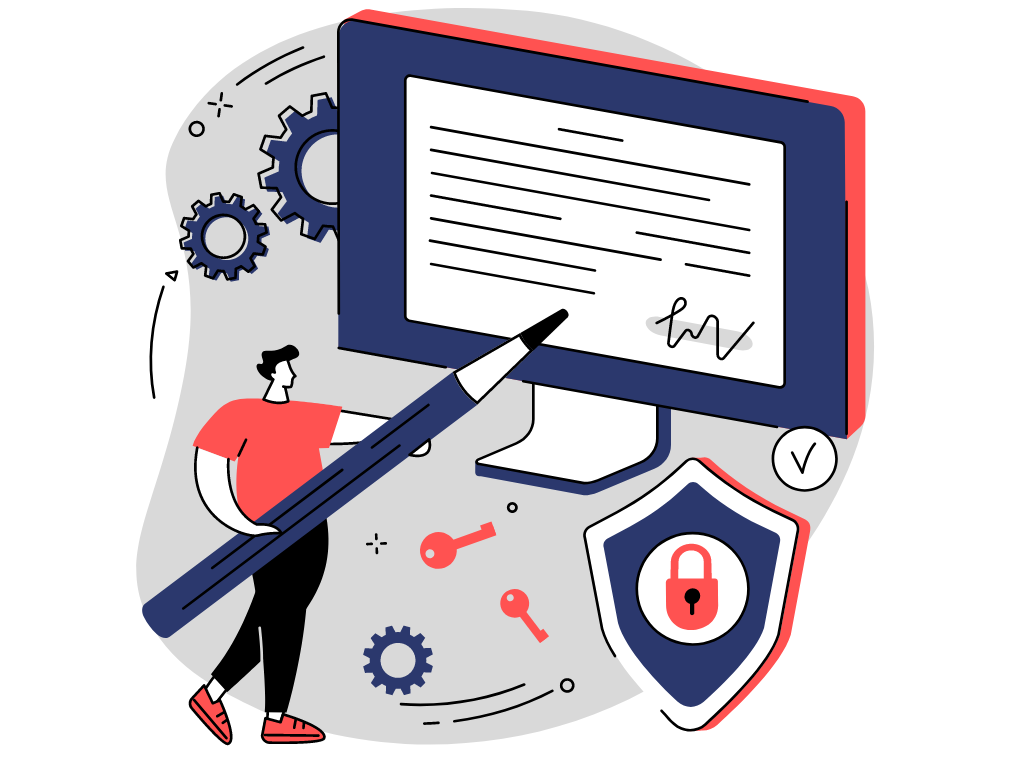
Digital signature vs. Electronic signature
Digital signature and electronic signature are not the same concept. Although the difference may seem subtle, it is not for auditors, judges, IT experts or instruments of the law.
We describe the digital signature as the technique used to achieve certain electronic signatures. This method is based on the application of cryptographic algorithms and aims to (1) identify the person signing the document and (2) accredit the authenticity of the signed document.
When we speak of electronic signature we refer to the broader concept used to enter into a legal agreement electronically. When we speak of digital signatures, we refer to the technical method used in some types of electronic signatures, which provides greater guarantees than a conventional electronic signature. Thus, we can say that all digital signatures are electronic signatures, but not the other way around.
Benefits of electronic signatures in companies & enterprise
The high growth of electronic signatures can be explained by different reasons. The digital transformation we have been experiencing in the last few years, the emergence of companies with digital-based business models, the internationalization of local or national companies, or large accelerators such as COVID-19, have pushed businesses to rethink their internal and external processes, relying on this technology as an ally.
There is no doubt that both professionals and companies of all sizes have adopted the electronic signature for its great positive impact on their businesses, experiencing positive results in the short term and maintained over time.
Explore the benefits of electronic signatures:
1. Greater guarantees and legal security
Electronic signatures provide a higher level of guarantees and security than paper signatures:
- Signed documents are protected and cannot be altered, guaranteeing their immutability and integrity over time.
- There is an increased guarantee that signed electronic documents are not exposed to loss, theft or manipulation, compared to documents signed on paper.
- Documents are delivered only to persons authorized to sign them, ensuring confidentiality in the signing process.
- Access to the document signature can be protected by an additional secret key, which is known only to authorized signers.
- Improved compliance by securely complying with laws and being able to prove it effectively.
- Evidences are generated to prove the signing process. For each signature process, a receipt of evidence or Audit Trail is generated, which is the proof document that contains all the evidence that proves the signature process. A particularity of eEvidence’s electronic signature solution is that it provides a receipt that collects all the evidences and is also electronically signed to guarantee its authenticity and immutability over time – a practice that not all electronic signature providers do.
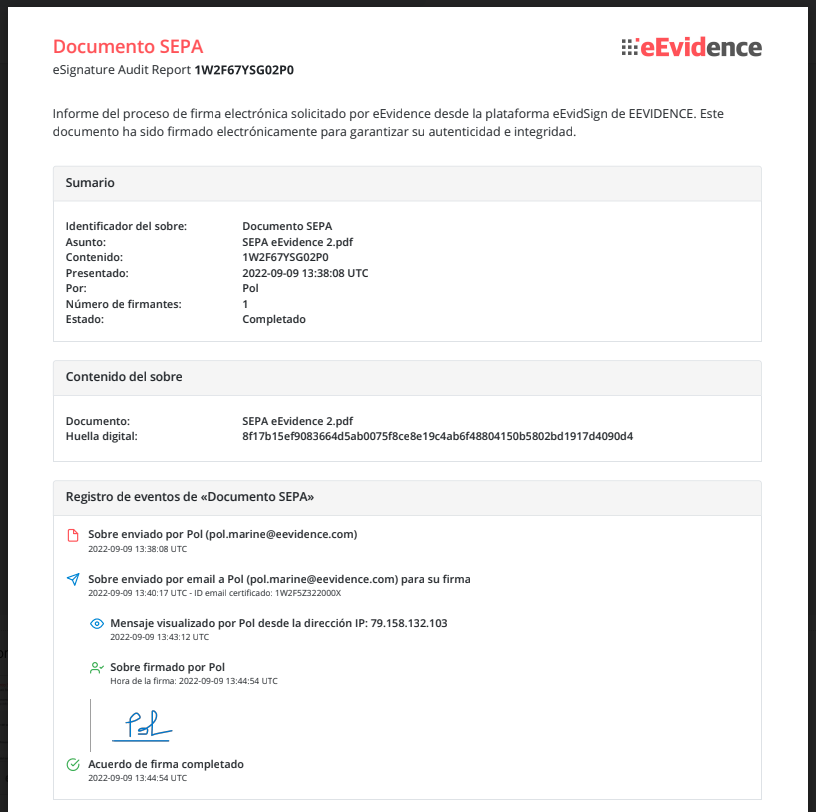
2. Cost savings and operational efficiency
Electronic signatures play an important role in generating operational savings for businesses:
- Removal of costs associated with printing, ink, paper and hardware maintenance.
- Elimination of the cost of physical archiving of documentation.
- For customers using eEvidSign, there is a significant reduction in the cost of registered delivery of documents by sending the documents via registered email or registered SMS – eliminating the high cost of bureaufax or postal registered mail while maintaining the same legal safeguards.
- Reduction of the administrative burden of the entire signing process; preparation, sending, tracking, signing, collection and custody of documents.
- Reduction of document signing times, estimating that a high percentage will be signed on the same business day.
- Greater ease and effectiveness in demonstrating the signing process and making documents available to the signer, reducing legal and economic risks associated with disputes and litigation.
- Acceleration of business-critical business processes, such as sales or contracting.
3. Improving the signing experience
The electronic signature provides a superior experience for all parties involved in a signature:
- For applicants: the process becomes faster, more convenient, intuitive, and is less tedious than paperwork, and can become fully automated. Multiple documents can be attached to the same signature request, sent to multiple signatories at the same time, and done from anywhere. In addition, it facilitates remote business and sales, avoiding travel and all the usual restrictions that come with being in person.
- For signatories: the process is much more convenient than signing on paper, being able to sign from anywhere and through the electronic device they are on. Access to the documents is secure and the signature is done in real time, without delays or waiting of any kind.
4. Increases the competitiveness of companies
The electronic signature represents a before and after in the way companies do business, whether they are oriented to the end customer (B2C) or to other companies (B2B).
In addition to enabling remote sales and contracting, it is a brilliant tool for facilitating legal processes and providing a better customer experience.
In cases such as start-ups, freelancers or SMEs, the implementation of electronic signatures represents an optimization of workflows and a significant reduction in ROI time.
5. Sustainability and positive impact on society
We are gradually leaving behind a world addicted to cellulose.
Today, more and more organizations are incorporating sustainability as one of their values and adapting their business strategy accordingly. Therefore, it becomes a double win when choosing greener solutions means both time and cost savings for the company.
Electronic signatures not only make it possible to sign documents remotely, but also have a great positive impact on our environment and on sustainability in general.
Legal validity of eSignatures
Are electronic signatures legal?
Yes, electronic signatures are legal and you can use them with full confidence as they are recognized and regulated in most countries around the world.
The existence of these regulatory frameworks has made it possible that electronic signatures have been rapidly adopted in the professional environment to carry out the acceptance of all kinds of important documents and agreements, replacing the handwritten signature on paper.
Let us now take a look at the regulatory framework in the different regions.

1. Legality of electronic signatures in the European Union
In the European Union, a common legal framework has been established for all countries known as the eIDAS Regulation, or Regulation (EU) No. 910/2014, which recognizes and regulates the use of electronic signatures throughout the territory.
Among other aspects, the eIDAS Regulation establishes that no signature may be denied legal effect or admissibility as evidence in legal proceedings solely on the grounds that it is in electronic form.
Additionally, the eIDAS Regulation recognizes and establishes three types of electronic signatures with different levels of guarantees as to their legal and evidentiary value. We will go into more detail on this point in the following section.
2. Legality of electronic signatures in Spain
Electronic signatures are legally recognized in Spain and are provided for in eIDAS Regulation 910/2014, Law 6/2020, of November 11, on certain aspects of Trusted Electronic Services, and Law 34/2002 on Electronic Commerce.
Firstly, as Spain is one of the Member States of the European Union, the provisions of the eIDAS Regulation of the European Union governs and is directly applicable in Spain. The eIDAS Regulation repeals Directive 1999/93/EC. This Regulation, in its Chapter 3 “Trust Services” and in its Section 4 “Electronic Signatures”, regulates the use of electronic and digital signatures throughout the EU, including Spain.
Secondly, and in accordance with Spanish law, electronic signatures are regulated by Law 6/2020, of November 11, on certain aspects of Electronic Trust Services (“Law 6/2020”). This law complements the eIDAS Regulation in those aspects that have not been harmonized, such as the liability regime, or the penalty regime, among others. Likewise, Law 34/2002, on Electronic Commerce, establishes additional provisions related to the enforceability of contracts entered into through electronic means.
3. Legality of electronic signatures in the United States
In the United States there is also a common regulatory framework for electronic signatures composed of two different laws:
- UETA, Uniform Electronic Transactions Act introduced by the National Conference of Commissioners of Uniform State Laws (NCCUSL) in 1999, and.
- ESIGN, Electronic Signatures in Global and National Commerce Act in 2000. In both cases, electronic signatures are given the same legal validity and effect as handwritten signatures.
4. Legality of electronic signatures in other countries of the world
For the rest of the world, there are different interpretations that make it possible to establish a basic legal framework worldwide, such as the OECD, UNCITRAL of the United Nations and the International Chamber of Commerce (ICC) guidelines.
Similar to what happens in the European Union or the United States, most countries in the world grant full legal validity and recognize the use of electronic signatures. Among these countries are: Argentina, Australia, Canada, Chile, China, Colombia, Costa Rica, Dominican Republic, Ecuador, Guatemala, Honduras, Hong Kong, India, Japan, Mexico, Nicaragua, New Zealand, Nicaragua, Paraguay, Peru, Philippines, Russia, Singapore, South Africa, South Korea, Switzerland, Turkey, United Arab Emirates, Uruguay and Venezuela.
Types of electronic signature
There are different types of electronic signatures on the market.
Particularly in the European Union, the eIDAS Regulation recognizes three types of electronic signatures:
- Simple electronic signature (SES)
- Advanced electronic signature (AES)
- Qualified electronic signature (QES)
It should be noted that all three types of signatures have legal effect. The differences between them lie in the level of guarantees provided by each in terms of legal and evidentiary value.
Additionally, companies that use the eEvidSign electronic signature solution always have the support of the signature receipt of evidence, which allows the process to be accredited with the relevant electronic evidence regardless of the type of signature chosen.
Let us now see what each one consists of and how they differ.
1. Simple E-Signatures (SESs)
The simple electronic signature is the simplest of the three and has sufficient legal effects for the vast majority of documents and use cases. It is the most widespread type of signature for personal and professional use.
According to Article 3 of the eIDAS Regulation, a simple electronic signature would be:
“Data in electronic form wich is attached to or logically associated with other data in electronic form and which is used by the signatory to sign”
Art. 3, Regulation (EU) No. 910/2014
Examples of a simple electronic signature would be:
- Clicking an I accept the data processing policy or cookies button on a website.
- Drawing a signature by means of an electronic device on top of a document.
- Checking an acceptance box of a contract in an electronic signature application.
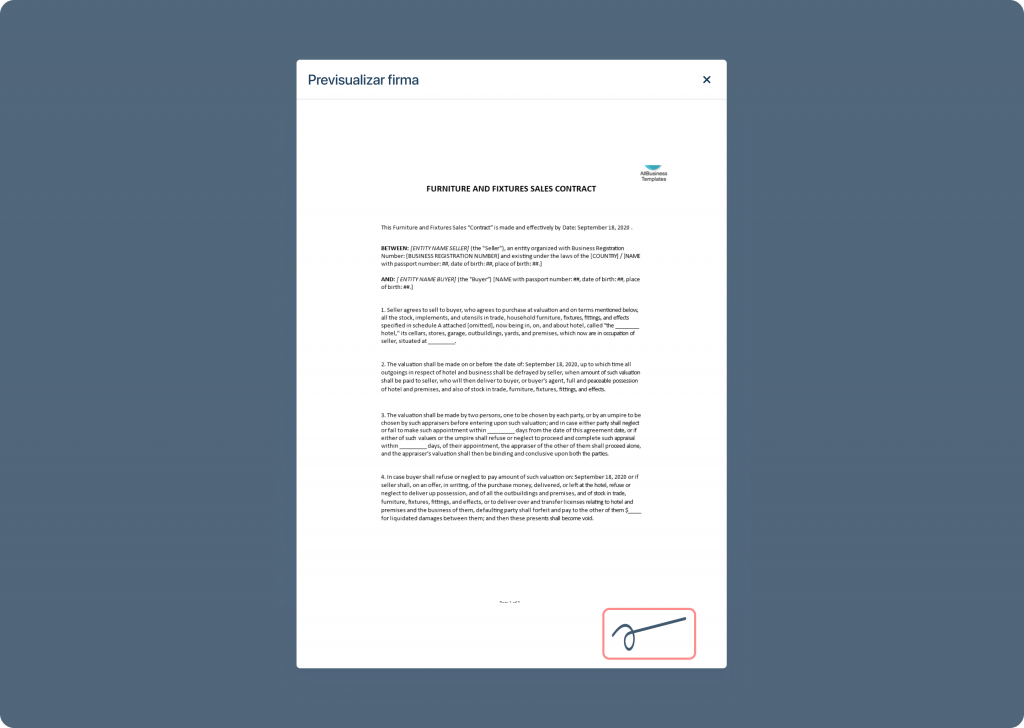
2. Advanced E-Signatures (AdESs)
The advanced electronic signature is a signature that allows the signer to be unequivocally identified and the authenticity of the signed document to be verified. It provides a higher level of guarantee than a simple signature.
What are the requirements for a signature to be considered advanced? According to Article 26 of the eIDAS Regulation, an electronic signature will be considered advanced when it meets the following requirements:
- “be uniquely linked to the signatory;
- allow the identification of the signatory;
- it is created using electronic signature creation data that the signatory can use, with a high level of confidence, under the signatory’s exclusive control; and
- be linked to the data signed by it in such a way that any subsequent modification of the data is detectable”.
There are different types of advanced electronic signatures, which vary depending on the method used for the identification of the signer and the signing system. Among the most common are:
- Advanced OTP signature: a unique key is sent by SMS to the signer to verify their identity.
- Biometric advanced signature: biometric data is collected from your signature device to verify your identity, with more or less accuracy, whenever possible.
- Advanced signature with single-use digital certificate: the OTP signature is combined to verify the signer’s identity with the issuance of a single-use digital certificate created on the spot for the signature of the document.
- Advanced signature with digital certificate: the signatory signs with his digital certificate, which he has previously obtained from an authorized qualified entity.
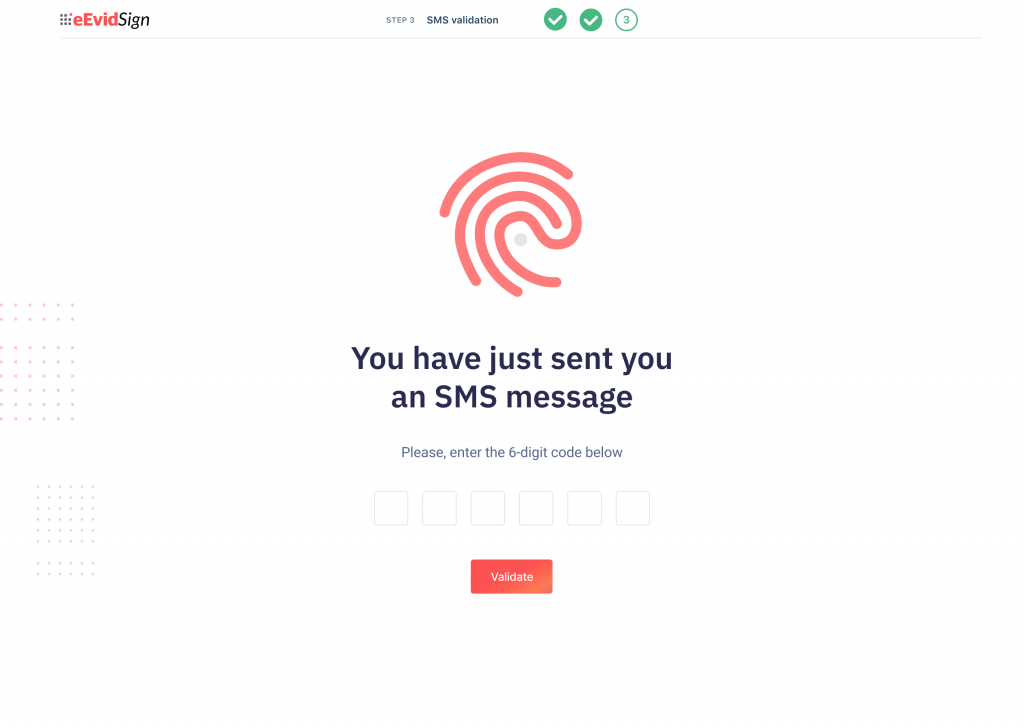
3. Qualified Electronic Signature (QESs)
The qualified electronic signature is the most secure signature, and also the most complex, considered the only digital signature equivalent to the handwritten signature.
It is an advanced signature created by a qualified electronic signature creation device, based on a qualified digital certificate for electronic signatures (article 3.12 of the eIDAS Regulation). This digital certificate must be issued by a qualified entity, which has unequivocally verified the signatory’s identity.
It is the highest level of signature, which enjoys a presumption of legal validity – in the event of a dispute, it will be considered valid without the need to provide additional evidence.
Qualified electronic signatures are usually reserved mainly for transactions with the Administration since they are highly complex and costly to implement. It is very rare to find it in private documents of professionals and companies.
What documents can I sign with an electronic signature
Technically speaking, any document that requires an acceptance can be signed electronically, regardless of the type of signature used.
In Spain specifically, law 6/2020 does not contain specific transactions that require the use of an advanced or qualified electronic signature. Therefore, generally, parties can use any form of electronic signature to create valid contracts that do not require additional guarantees.
From a practical perspective, it would be acceptable to use any type of electronic signature for private documents.
In the following image you can see an overview of the main documents you can sign:
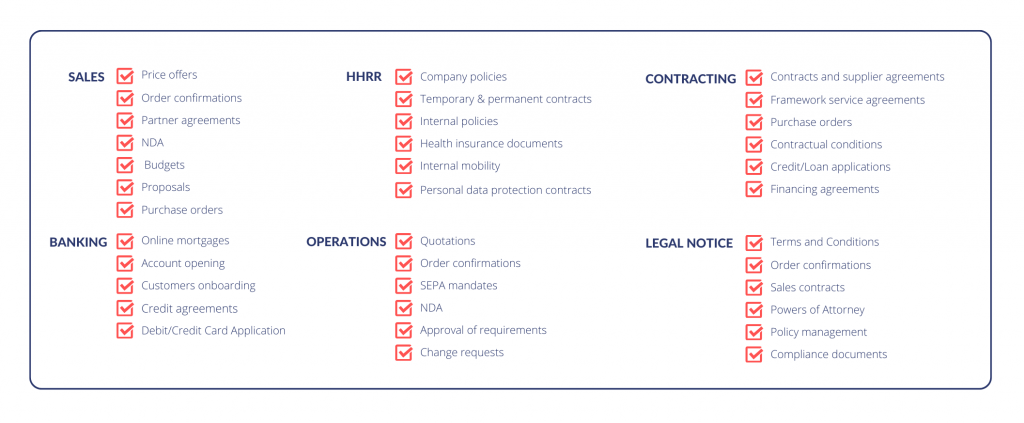
Switch to eEvidSign’s electronic signatures
Signing documents does not have to be tedious, legally unsafe or cost your company a lot of money. On the contrary.
Meet eEvidSign, eEvidence’s electronic signature solution, ideal for companies looking to manage document signatures in an agile, intuitive and secure way at a fair price, even on a large scale.
The solution offers two differentiated electronic signature products:
- eEvidSign Platform – The simple and easy-to-use eSignature cloud platform that allows you to manage your signature processes and send your documents to sign in 1 minute. Ideal for freelancers and small businesses, who are new to e-signatures or who are already working with a similar program and are looking for a simple product that offers superior legal security and with the fair price philosophy that characterizes eEvidence.
- eEvidSign API – The powerful eSignature API that offers maximum flexibility to create customized signature experiences integrated with the workflows, systems and environments of each company. Ideal for medium to large enterprises that need a tailored solution and aspire to provide a signature experience perfectly aligned with their excellent customer experience.
If you are looking for a reliable, expert and honest provider, I encourage you to explore our eEvidSign electronic signature solution, which complies with the strictest regulatory frameworks globally.
Welcome to eSignature, the best way to sign documents.
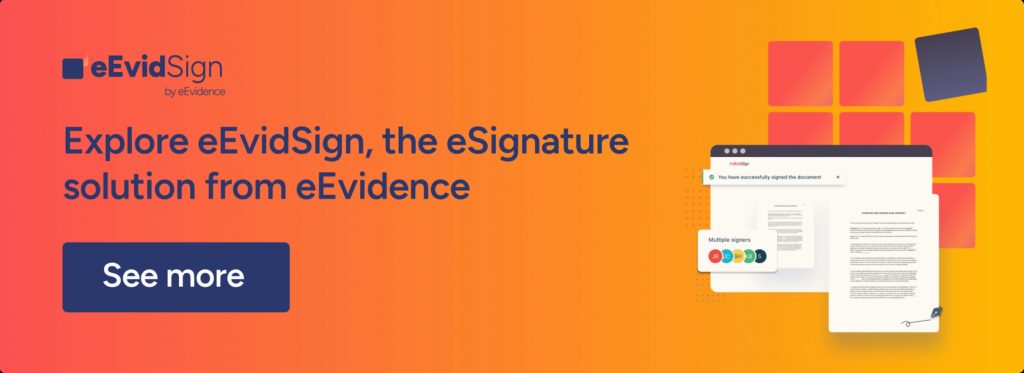
If you are looking for a reliable, expert and honest provider, I encourage you to explore our eEvidSign electronic signature solution, which complies with the strictest regulatory frameworks globally.
Welcome to eSignature, the best way to sign documents.
If you are interested in starting to sign your documents with greater guarantees and you are a professional, particular and/or small company, do not hesitate to consult the different rates available and register. If on the other hand, you are a company with high volumes of shipments and needs tailored to your project, please contact us.


